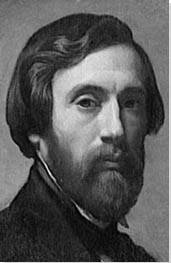Summary of Charles Gleyre
Gleyre's reputation was built on a series of works based on classical parables, but also as the teacher of the future Impressionists. Although often thought of as a conservative artist, he can be credited, next to Paul Delaroche and Thomas Couture, with creating what became known as the juste-milieu ("happy medium") painting style. It was a form of painting that sought to bring modern innovations to academic paintings. Once established as a significant figure on the Salon circuit, Gleyre took over Delaroche's Paris studio and transformed it into what was arguably the most progressive school in Paris. His was a radical set up in which his students - which included the likes of Claude Monet, Auguste Renoir, Alfred Sisley, Jean-Frédérick Bazille and James McNeill Whistler - were offered a say in the day-to-day running of the atelier. A man of strongly held political beliefs, his studio doubled as a meeting place for liberal thinkers but, just as his party politics failed to transform French society, so his eyesight failed him too, and in his later years he withdrew more and more from public life.
Accomplishments
- It might be most accurate to label Gleyre a "romantic academic" given that his best-known works brought the forms, colors and sounds of his journey throughout North Africa and the Eastern Mediterranean to bear of his reimagined mythological and history paintings. It was an approach that divided the opinion of traditionalists but established him as a unique voice within eighteenth-century academy painting.
- Many historians have suggested that Gleyre greatest contribution to the canons of eighteenth-century art was as the head of a studio which he inherited from Delaroche. Under Gleyre's direction the studio - which was dubbed "The Republic" because it afforded (amongst other things) students a voice the running of the school - broke new ground in its open approach to teaching and learning and some of the greatest artists of the late-nineteenth century passed through its doors.
- Gleyre once dismissed landscapes as "good for the youth who haven't yet had their First Communion or for old people who no longer have sufficient imagination to invent subjects and paint figures". But in his highly personalized and evocative visions of the ancient past, he invested great imaginative detail in his landscapes. Often featuring desolate desert, mountains and sparse outcrops, his terrains, which drew directly on his memories of North African in the mid-afternoon, provided uniquely exotic backdrops to his historical and mythical parables.
- Gleyre's art often provided a vessel for his impassioned political opinions. At the same time he earned a reputation for the dedicated way in which he went about researching his subject matter, and the subtle ways that research revealed itself in fine narrative details. On this topic, the Musée d'Orsay observed that his "complex compositions [aimed] to be instructive and to inspire the cathartic emotion of a face-to-face encounter with the heroes of a history [but] viewed afresh through the prism of his Republican beliefs".
The Life of Charles Gleyre
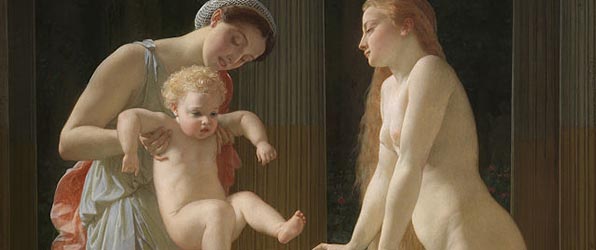
Justifying his practice of reinterpreting the stories of antiquity through the lens of personal experience, Gleyre was quick to remind his distractors that the major Greek sculptor "Praxiteles borrowed the better elements of a hundred imperfect models in order to create a masterpiece".
Important Art by Charles Gleyre
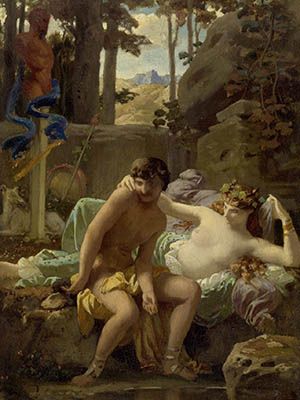
Cleonis and Cydippe
The mythological character of Cydippe briefly appears in Book IV of Virgil's Georgics. Assuming Virgil was Gleyre's only source, this episode, and the personage of Cleonis, have been born of the artist's imagination. The palette is of an all-over cool blueish tone that refers to Cydippe's identity as a Nereid or water nymph. Cleonis turns from Cydippe here with languid arms as if uncertain, timid or mournful. Cydippe's reassuring arm grasps him round the neck as she looks at Cleonis intently.
Cleonis's tanned body tells us of an active masculinity while Cydippe's body is pale and in a recumbent position, usually an indication of passivity. However, despite the fact she is reclined, it is Cydippe who is active here, in her expression, searching eyes and her gesture. Cleonis is sitting but seemingly paralysed by reticence. Gleyre could be attempting to portray the "dangerous wiles" of woman operating on the unsuspecting sincerity of men. Or this could be an exercise in the blurring of the line between masculinity and femininity, as Cleonis is painted as if stultified by Cydippe's touch and gaze.
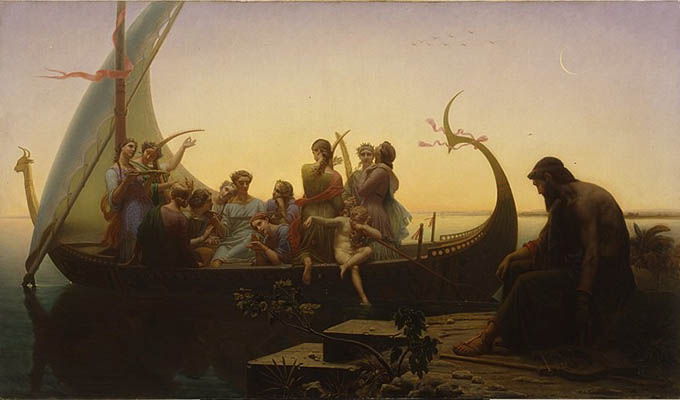
Evening
This work, which brought Gleyre brief acclaim at the 1843 Salon, blends Classicism with Romanticism. In terms of the subject-matter, and Gleyre's highly refined drawing, it belongs within the classical tradition. Yet the picture's prevailing mood is one of introspection which is in keeping with the Romantic obsession with emotion and subjectivity. The mood of the work converges on the seated man in shadow but is also evident in the depiction of the subtle light of the dying day.
The episode has not been found in mythology or ancient history and seems to have been a creation of the artist's imagination. The man is a poet, a cipher perhaps for the artist himself, as a lyre lies on the ground next to him. He is slumped over while he watches the departing boat which catches the last of the sunlight, while he is in shadow. Large in scale given his proximity to the viewer, the poet is shrouded in dark tones that obscure his muscularity and which could be analogous to his waning creative powers. The ensign and flags of the boat show the direction of the wind as the muses of poetry and song drift away, leaving the bereft poet to his saturnine mood of self-contemplation. His darkness can also be read as blindness which doubles the painting's meaning. It can refer to the inability to render eternal truths through art and to the mythical blindness of Homer. This twofold significance of Gleyre's dark poet brings out a certain pathos: rather than the trope of the seer-poet who is physically blind such as Homer, this poet's blindness is barren. There is a similar contrast between the song-making of the departing muses; their faces enlivened and one of whom looks to the sky with a wreathed head, and the poet. Bearing down upon the poet is the sole adornment of an almost eclipsed moon that rhymes with the light fading from his face.
Conceived originally by Gleyre after a near-hallucinatory experience on the banks of the Nile, he wrote in his journal at the time that "the triple harmony of forms, colours and sounds was complete". The picture's fading subtle light, the carefully rendered volumes of the figures and the music-making of the muses show an attempt to recapture the synesthetic experience. The art historian William Hauptman has written "the boat filled with ghostly and spiritually distant figures brings the classic-romantic conflict into a telling unity and at the same time appeals to the persistent taste in France for introspective reflection and poetic reverie in painting".
Oil on canvas - Louvre
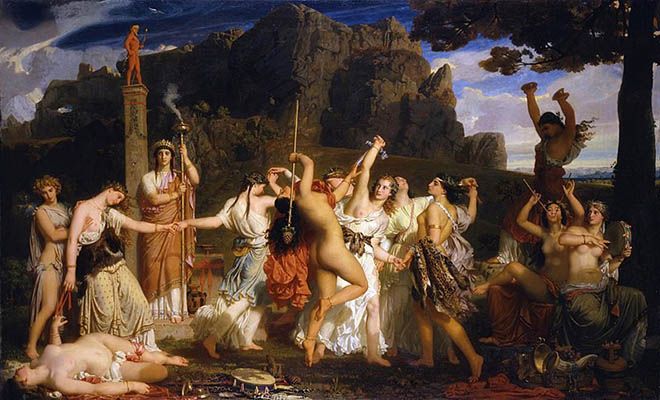
The Dance of the Bacchantes
Brightly lit, for the most part, beneath a dramatic sky of movement that seems to imitate the sacred ritual's dancing, is a scene of the devotees. The sheer rock face of the background masks the ceremony from the broader countryside and emphasises its secrecy. As has been noted that Gleyre has, unusually for such a scene, excluded icons of masculinity: there is neither Silenus nor the typical male satyrs of the woodland. Bacchus himself is only present in the form of his bronze statue on the column to the left. This religious and intoxicated fervour is here the preserve of women. This divergence from conventional depictions of the subject is symbolised by the central dancer who holds Bacchus's inverted staff (thyrsus), its pinecone pointed to the ground. The composition is in the arrangement of a classical frieze in a narrative that follows the stages of activity from right to left. From the right where we see the two seated bacchantes playing music, to the central dancing group, the eye moves to the left where inebriation has taken its toll; except for the incense-burning priestess who stands upright in front of the column of Bacchus.
The priestess along with the seated pipe player (second from the right) are the only two characters who peer out at the spectator. This creates a tension between the exclusive nature of the clandestine ritual within the pictorial world and the visibility of Gleyre's portrayal of it to the spectators of the painting. An unnamed critic has remarked of the work's "choreography, which is both noble and unbridled, frenzied and rhythmic". But for all of the "frenzy", Gleyre's orderly and schematic composition, which seems to crystallise in the thyrsus-bearing dancer, confers the balanced nobility that the critic referred to. The artist seems to delicately counterpoise reason and its subversion.
The Musée cantonal des Beaux-Arts de Lausanne says of the work: "There is no wild eroticism with the Swiss master, just partially denuded bodies bestowing a delicately sensual note on the scene; no frantic savagery, but instead a severe ritual. Gleyre renews the iconography by turning the bacchanal into a cultic and mystic moment. But if his Antiquity is meditative, it is not so dreamlike as to overlook even the slightest archaeological detail, which he revisits in the light of contemporary research, particularly with regard to polychrome sculpture".
Oil on canvas - Vaud Museum of Fine Arts, Lausanne
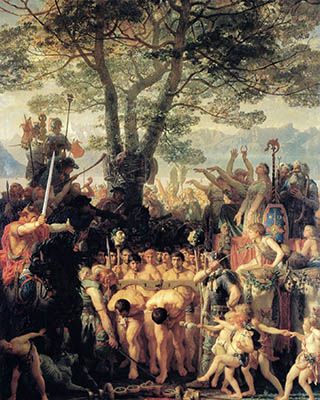
Romans Under the Yoke
Gleyre's growing reputation drew attention from his homeland and secured him this commission depicting the celebrated victory of the Helvetians over the Romans at the Battle of Agendicum (modern-day Agen) in 107 BCE. The image is emblematic of the independent spirit of the Swiss people who, over the centuries had suffered Habsburg, French, Russian and Austrian invaders.
In the foreground, stooping soldiers pass beneath the yoke. This contrasts with the huge and sturdy oak wrapped with captured Roman shields, and the upward gaze of the wreathed priest in the right middle ground who seems to ascribe the victory to providence. Perhaps Divico, the leader of the Tigurini tribe and orchestrator of the triumph in the field, is on horseback raising his sword obscuring his face on the left. Certainly his gesture portrays a martial disposition. The obscuring of his face by Gleyre could mean the canvas is not a commemoration of a great leader but rather an entire people's love of freedom.
In this peopled scene of raised gazes, swords and standards, the Roman ensign lies on the ground broken and to be trodden upon by the prisoners. Not only does Gleyre, with the picture's sense of jubilation, sound the note of Swiss independence, it also includes a note of compassion as evident in the right foreground where a child offers a wet cloth wrapped on a branch to succour the defeated. This is in contradistinction to the raised severed heads of the Roman generals Longinus and Piso Caesonius beneath which the prisoners pass, grisly symbols of a fierceness when pushed to war. The Roman academic Penelope Uchicago adds that "Although the Battle of Burdigala is thought to have taken place on the border of Aquitania (near Agen on the Garonne)" the painted scene was shifted to "Montreux on the eastern shore of Lake Geneva, allowing the artist to depict in the background the mountains of the Dents du Midi across the lake - and to portray what historically would have been constructed of spears as a literal ox yoke".
Oil on canvas - Vaud Museum of Fine Arts, Lausanne
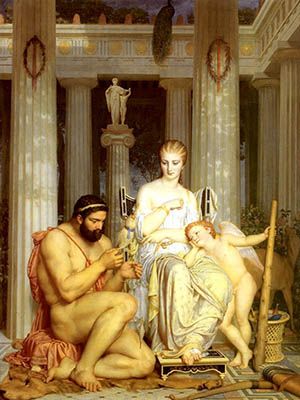
Hercules and Omphale
Hercules's punishment for "inadvertent murder" was to stay in the house of Omphale, a Lydian princess, for a year and attend to duties seen as womanly. So here Gleyre depicts the flawed hero spinning thread sitting at the feet of a watchful Omphale. In some renderings of the tale, Omphale was said to wear Hercules's skin of the Nemean lion and he her clothing. Gleyre feminizes Hercules by giving him an amber robe. But Omphale retains her female drapery, alluding to not so much a gender role reversal as to the humiliation of the masculine hero. Hercules's bronzed complexion together with the delicate shadows of external foliage on the columns to the rear signal his life of action in the mythic realm while Omphale's pallor situates her always in the interior space which Hercules now inhabits. Yet he sits on the skin of the lion, his club rests on the floor to the right and the Doric order of columns, indicative of strength, tells of the transience of this punishment. With his resumption of the male role at the end of the year, the couple were said to have married.
Gleyre's friend and prominent critic Charles Clément remarked of Gleyre as "a talent whose strength and severity pleases both the demanding and the delicate, and which has at the same time the charm and grace that seduces the crowd". This picture epitomises the delicate balance of erudition and force on one hand, and a certain elegance of colour and gesture on the other.
Oil on canvas - Musée d'Art et d'Histoire, Neuchâtel
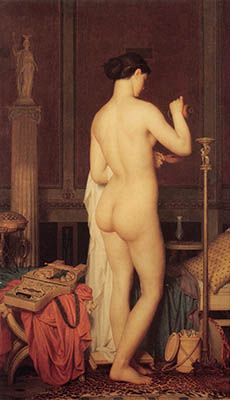
Sappho
Just as in the Dance of the Bacchantes, where Gleyre equated religious fervour with the feminine, here the mysteries of artistic inspiration are available only to the feminine, just as in Evening. Known in ancient times as "The Poetess" or "The Tenth Muse", Sappho's reputation was almost peerless. In concord with the latter epithet, Gleyre has placed in the left background an effigy of Athena, sister of the Muses, as protector of the poet's art.
Sappho stands in a confident and self-possessed stance, turning away from the viewer while pouring a cup of wine. The viewer is not privy to her facial expression, nor whether this moment is a prelude to, or the aftermath of, her composing. Either way, her lyre sits nearby on the couch. This uncertainty regarding her practice - her turning from us and the ambiguity of the moment - is perhaps fashioned by Gleyre as not only inscrutable to the viewer but also to him. In this case, Sappho's legendary inspired poetic vision also implies the melancholic self-doubt of Gleyre about his own status and legacy. It is significant that Gleyre chose not to paint Sappho performing.
Writing of Gleyre, the art historian Albert Boime said, "he deliberately elevated the nonepisodic (sic) to the level of grande peinture, laying aside the drama and heroism of antiquity in favour of a more prosaic moment". In this moment, the near-mythological status of both Sappho's gift and tragic stature is conveyed more by Gleyre's treatment of subtle, almost clouded, colour tones and the drawing of the human form than by the unremarkable triviality of Sappho's pouring of wine.
Oil on canvas - Vaud Museum of Fine Arts, Lausanne
Biography of Charles Gleyre
Childhood
Marc Gabriel Charles Gleyre was born in Chevilly, a small village in the French speaking Vaud region of Switzerland. Although little is known of his formative years, it is known that Charles's parents died when he was eight or nine and he was taken into the care of his uncle, a modest broker, who lived in Lyon, France. His enrolled his nephew in a technical college in Lyon with the expectation he would work in the textile industry.
Early Training and Work
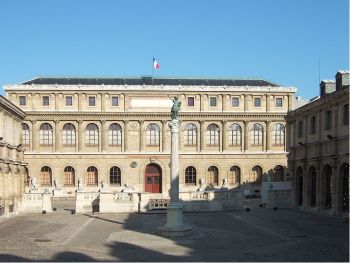
Showing a lack of aptitude for design work, his interests leaned instead towards fine art. He attended his first formal lessons in Lyon under Jean-Claude Bonnefond, a painter renowned for peasant scenes rendered in a cool, precise style. By 1825 Gleyre had moved to Paris where he studied at the École des Beaux-Arts and enrolled at the studio of Louis Hersent. It was here, according to Musée d'Orsay, that "Gleyre displayed a distinctly Romantic temperament in love with freedom and excess. He copied Théodore Géricault and Pierre-Paul Prud'hon, tragic figures whose recent demise was a frequent subject of conversation in the studio".
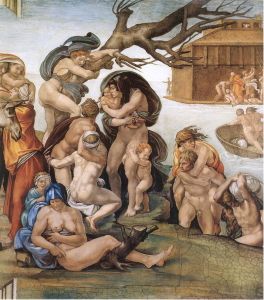
In 1828 Gleyre travelled to Rome to absorb the Italian capital's heritage. But his Roman sojourn was blighted by inactivity and a general feeling of despondency which was brought on by his wonder at the beauty of the Renaissance Masters, and in particular the works of Michelangelo. Gleyre was so humbled in fact that his mood turned somewhat misanthropic. In a letter home he wrote: "I don't see anything in the world that is worth a hope or a regret. I distrust all men and myself most of all". The d'Orsay records, however, that while in Rome, Gleyre "made the acquaintance of fellow Swiss artist Léopold Robert, whose scenes of brigands in the Roman countryside, a picturesque, heroic and modern subject, were hugely successful at the time. Drawing on the same subject, in 1831 Gleyre produced his first painting, The Roman Brigands, a scene of unprecedented sadistic realism. In line with the frenetic songs of Berlioz [the French romantic composer], the work was so violent and irreverent that it could not be exhibited and was doomed to languish unseen in his studio. From then on, the young painter was painfully aware of the gulf between his dream of fame and the freedom to express his creativity".
In April 1934, a despondent Gleyre met the French painter Horace Vernet who recommended him to an eccentric American philanthropist named John Lowell Jr., who was looking for an artist to document his ethnographic tour of North Africa and the eastern Mediterranean. The d'Orsay records that "Gleyre initially shared his patron's enthusiasm [for the tour] and produced stunning watercolours of sites ranging from Pompeii to Luxor, but the increasingly exhausting and dangerous conditions on the journey, punctuated by dysentery, sunstroke in 45°C heat in the Nubian desert, and a serious eye infection [trachoma] sapped the young painter's strength and morale". Their journey, which took in Greece, Turkey, Sudan and Egypt (where Gleyre entered into a relationship with a Nubian woman), lasted from early 1834 until November of the following year. By now Gleyre was fearing for his health (not to mention the sanity of his employer) and left Lowell (who died six months later in Bombay) in Khartoum and set off for home; a treacherous journey that took him over two years.
Despite the toll on his physical and mental wellbeing, the d'Orsay described how the artist's "adventure of a lifetime [...] set him apart" from other Orientalists: "In the 1830s, even the most daring among them [Orientalists] neither ventured beyond the confines of Greece, which had just thrown off the shackles of Ottoman rule, nor beyond the Turkish coast and the North African countries colonised by French troops. Gleyre's epic journey therefore had little in common with the comfortable diplomatic mission which Eugène Delacroix had accompanied to Morocco two years earlier".
Mature Period
Having arrived back in Lyon in 1838, in what he described as an "infinitely worse state than the prodigal son", Gleyre regained his health before moving to Paris where he set up a small studio on the rue de Université. Thus began his life-consuming preoccupation with painting and republican politics. In this modest dwelling, Gleyre began to build a career as a history painter. Initially, he sought to exploit the public demand for scenes of eastern exoticism. He worked up his watercolors and sketches into finished paintings but his enterprise failed him before a wholly unreceptive public. This set back led him to begin producing imitations of works by Alexandre Decamps, Horace Vernet and Eugène Delacroix. Though copies, these works brought him some financial stability, but very little by way of artistic fulfilment.
Having abandoned his Oriental imitations, Gleyre was free to concentrate on his own art and produced two decorative panels, Diana leaving the Bath, and a Young Nubian, but these failed to attract significant public attention. He soon gained recognition, however, with St. John on the Island of Patmos which he exhibited at the 1840 Salon. Though reviews of the painting were somewhat lukewarm, it led to many lucrative commissions. One such commission came from the Duc de Luynes who employed Gleyre to decorate the grand staircase of the Château de Dampierre, in the Chevreuse Valley. Gleyre began working on an allegorical piece but the commission turned out to be a bona-fide disaster for the artist with scathing criticism of his work-in-progress coming from by none other than Ingres (who was decorating an adjacent chamber). Indeed, the celebrated Neoclassical master, and erstwhile teacher of Gleyre, comments led to half the original work being painted over and restarted.
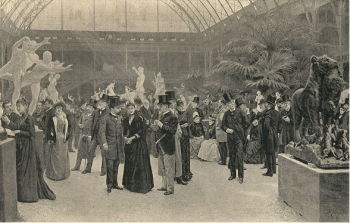
Like the phoenix rising from the ashes, Gleyre's reputation soared at the Salon of 1843 with the display of Evening, later named Lost Illusions. As the d'Orsay records, the painting "met with unanimous acclaim from the public and critics alike. It was awarded a gold medal and acquired by the French State, which exhibited it at the Musée royal des artistes vivants (Royal Museum of Living Artists). Widely disseminated as a print with the Balzacian title The Lost Illusions, the picture became embedded in the popular imagination of several generations of French people". Newly galvanized, Gleyre painted Separation of the Apostles (1845) which was also bought by the French State and word of his rising star soon reached his homeland of Lausanne. He was commissioned to produce two large historical paintings, Major Davel and Romans Under the Yoke, both of which commemorated Swiss independence. The works were hailed as national masterpieces and took pride of place in of Lausanne's newly built Museum of Fine Arts.
In 1843, Gleyre took over the Paris studio of the renowned history painter, Paul Delaroche. While under Gleyre's 25-year management, the atelier took in over 600 male and female students. Gaining a new reputation for its open approach (it welcomed both historical and landscape painters) Gleyre counted amongst his students Jean-Louis Hamon, Jean-Léon Gérôme, James McNeill Whistler, and future pioneers of the Impressionist movement, Claude Monet, Pierre-Auguste Renoir, Alfred Sisley and Frédéric Bazille. In keeping with Gleyre's political sympathies, the atelier was tagged "The Republic" and his students were invited to pay a voluntary contribution in exchange for a voice in the running of the studio. Yet the ideas of the master and his pupils could be incompatible with younger, "modern", students who were not won over by their master's historical subject matter. Yet Gleyre was innovative in crucial aesthetic areas. He introduced the method of covering oil with pastel, a modern technique that would later prove popular with the likes of Edgar Degas. He also encouraged painting en plein air which was the preferred method of the Impressionists. Renoir later explained that the benefit of learning in Gleyre's studio was that his pupils were granted free rein in terms of process and aesthetic.
According to the University of Glasgow (and its collection of the correspondences of Whistler) by the time "Whistler arrived in Paris in the summer of 1855 Gleyre's studio carried an air of fashionability [and through] Gleyre, Whistler learned to systematically arrange the colours on his palette and to paint in opaque pigments over a dark ground". It adds that although Whistler would eventually rebel against the studio set up, Gleyre's "method essentially informed his painting practice throughout his career [and that] even later works such as Arrangement in Black: Portrait of F. R. Leyland and Arrangement in Black, No. 2: Portrait of Mrs Louis Huth showed Whistler still following 'the system taught by Gleyre'". (The radical reputation of "The Republic" was confirmed, meanwhile, when satirised by George du Maurier in his hugely popular 1885 gothic novel Trilby).
Late Period
Untouched by the allure of fame and fortune, Gleyre preferred the quiet and solitary pursuit of his artistic goals. He worked slowly and methodically, bringing some paintings to fruition years after their beginnings. He rarely exhibited at the Salon after his earlier forays. He did, however, develop an ardent interest in the politics of the day and during the reign of Louis-Philippe his atelier became a meeting place for a group of liberal thinkers. Gleyre was a staunch Republican, as was made evident in his glorification of the people in his Romans Under the Yoke (1858).
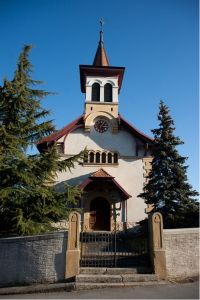
His snub of the offer of the Legion d'Honneur, and his abstention from showing at the Salon, merely confirmed Gleyre's credentials as a radical. However, after the coup d'état of Louis Napoleon in 1851, the Napoleonic family legacy had come to stand for aristocratic entitlement. The situation was a fatal assault on Gleyre's political sensibilities and he retreated even further from public life. He was met with a further blow when, in 1864, he had to retire from teaching due to a serious eye ailment. The studio suffered financial hardship and finally closed its doors in 1870 on the eve of the Franco-German war. His final, unfinished canvas was Earthly Paradise, a serene mirror-image of the lamenting melancholy of Evening, which the writer Hippolyte Taine described as "a dream of innocence, of happiness and of beauty - Adam and Eve standing in the sublime and joyous landscape of a paradise enclosed in mountains".
Gleyre died in 1874 and his remains were moved no less than four times. Firstly he was interred in Montparnasse Cemetery in Paris, then at his birthplace in Chevilly. He was move from there to the more central Calvaire Cemetery in Lausanne in 1896, before finally being returned to Chevilly in 1947. Gleyre never married and remained a life-long Swiss citizen.
The Legacy of Charles Gleyre
Gleyre remains largely unknown outside the scholarly sphere of nineteenth-century Academic painting, and even then he is often better remembered as the teacher of some of the leading Impressionists. Artists like Renoir, Bazille and Sisley could be said to have learned from Gleyre's dictum of "always thinking of it" in relation to the producing the work at hand. His promotion of plein air painting also had a profound influence on the practice of the Impressionists. Yet it is simplistic to reduce Gleyre to the role of tutor.
He was a key influence on the idea of "antique realism", a technique which mitigated some of the harsher aspects of the burgeoning Realist movement. It was adopted by his students Jean-Léon Gérôme and Auguste Toulmouche and informed Academy painters such as Bouguereau and Chavannes. Gleyre also anticipated Symbolism in art. His attempts at a synesthetic experience in Evening or Romans Under the Yoke (1858), for instance, points beyond the realistic or the idealistic portrayal of the world, towards a more mysterious realm in which the origins and workings of creativity are typically related to the feminine. Indeed, in this relation, Gleyre went beyond the tradition of representing womanhood in terms of either domesticity or the exotic nude. He was also a key influence on the Neo-Grec (Greek revival) school which became popular in painting, the decorative arts and architecture during France's Second Empire (1848-65).
Influences and Connections

-
![Jacques-Louis David]() Jacques-Louis David
Jacques-Louis David -
![Théodore Géricault]() Théodore Géricault
Théodore Géricault - Jean-Claude Bonnefond
- Louis Hersent
- Pierre-Paul Prud'hon
- Horace Vernet
- Léopold Robert
-
![Jean-Léon Gérôme]() Jean-Léon Gérôme
Jean-Léon Gérôme - Auguste Toulmouche
- Charles Clément
-
![Symbolism]() Symbolism
Symbolism - Academicism
Useful Resources on Charles Gleyre
- Charles Gleyre: Le genie de l'inventionOur PickBy Catherine Lepdor
- Charles Gleyre: 1806-1874Our PickBy William Hauptman
- Gleyre: étude biographique et critiqueOur PickBy Charles Clément (A catalogue raisonné and critique that resurrected Gleyre's reputation)
- Charles Gleyre Ou Les Illusions PerduesBy Rudolf and Jacques-Edouard and Rene Berger Koella
- L'academisme et ses fantasmes: le réalisme imaginaire de Charles GleyreBy Michel Thevoz
 Ask The Art Story AI
Ask The Art Story AI